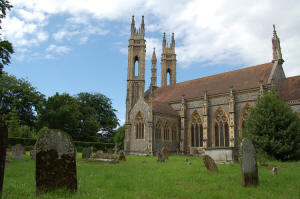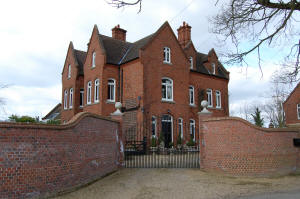Booton
Driving along the narrow country lane from Reepham,
you suddenly encounter the church of St. Michael the
Archangel - surely one of the most bizarre and
incongruous buildings in the whole of Norfolk. It has
ornate slender towers and a central minaret making
it look out-of-place in such a rural Norfolk
setting. Dubbed the 'Cathedral of the Fields', it was
the brain-child of the Rev Whitwell Elwin who was rector
in the village from 1850-1900.

St. Michael the
Archangel at Booton
Elwin, a self-taught architect, began to rebuild
Booton church in 1876 and he devoted great energy to the
task until his death 24 years later. The hammerbeam roof
inside - depicting angels - is famous and was modelled
on the church at Trunch which
Elwin knew as a child. The architect Edwin Lutyens
described the building as ' very naughty but built in
the right spirit'.
Across the fields you can see the spectacular (and
more conventional) church of St. Agnes at
Cawston -
which was one of Sir John Betjeman's favourites.
Elwin, who was descended from the native American
princess Pacahontas, was the editor of the Quarterly
Review from 1853-1860. His literary friends included
Dickens, Thackery, Sir Walter Scott and John Murray. In
fact, Thackery and Scott visited him at Booton. Elwin
was also the editor of the standard edition of Alexander
Pope's poetry.
Kate Charles' mystery novel Evil Angels Among Them
(1995) is set in this part of Norfolk and features the
fictional church of 'St. Michael and All Angels' - which
may have been based on Booton church.
Booton also has another literary link - in the form
of Stephen Fry. It was here that the actor, director,
comedian, script writer, TV presenter, novelist, poet
and national treasure grew up.

Stephen Fry's childhood home at Booton His family moved to the
village in 1965 and in his autobiography Moab is My
Washpot - he describes the sense of isolation that
he originally felt at the move:
|

